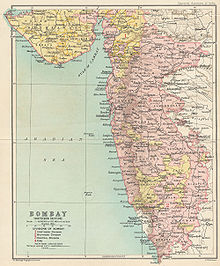Bombay (presidency)
The Presidency of Bombay ( English Bombay Presidency ) was a province of British India from 1618 (first British settlement) or 1858 (beginning of direct British rule) to independence in 1947, when the province became the state of Bombay .
At the time of greatest expansion, the presidency included the present-day Indian state of Gujarat , the western two-thirds of Maharashtra including regions Konkan , Desh and Kandesh and northwestern Karnataka , in the southeast of present-day Pakistan belonged to Sindh to also the in Yemen situated Aden . Like the rest of India, it consisted of districts under direct British administration and states ruled by indigenous princes supported by a British governor.
Beginning of British rule
The first British settlement in the presidency since 1612 was Surat in what is now Gujarat . The English East India Company established a trading post here, which was under the protection of the Mughal ruler Jahangir . In 1626, England and the Netherlands tried in vain to acquire the island of Bombay from Portugal , and in 1653 proposals were made to buy it. In 1661 Bombay was ceded to Great Britain as part of the dowry of Infanta Catherine of Braganza , bride of the English King Charles II. In 1668, however, the city was ceded to the East India Company for an annual payment of £ 10. The military installations were also handed over, and a regiment established in Europe was stationed in Bombay. The fortifications proved sufficient to repel a Dutch attack in 1673. In 1687 Bombay became the capital of all the company's possessions in India, but in this role it was replaced by Calcutta in 1753 .
Expansion of the area
During the 18th century, the Hindu Marathi Empire expanded very rapidly at the expense of the crumbling Mughal Empire , conquering Konkan and eastern Gujarat . In western Gujarat, including Kathiawar and Kachchh , the loosening of Mughal control allowed many local rulers to become virtually independent. In the Marathas Wars (1774–1782, 1803–1805 and 1817–1818), most of the Marathas Empire was conquered by Great Britain .
In 1803 the Bombay presidency consisted only of the island of Salsette , on which Bombay is located, Surat and Bankot . The remaining areas were added by 1827. The numerous small states in Kathiawar, Mahi Kantha , Palanpur and Rewa Kantha were organized between 1807 and 1826 as "sovereign" princely states under British control. Baji Rao II. , The last Peshwa (Prime Minister) of the Marathas Empire, received a pension in 1818.
Aden was added to the presidency in 1839 and Sindh in 1843 . During the Sepoy uprising of 1857-1858 , the province remained relatively quiet. As a result of the American Civil War and the blockade of the southern states, agricultural production increased sharply as Indian cotton replaced American cotton in Europe. The money flowing into the country as a result led to a speculative bubble and the collapse of the Bank of Bombay in 1866. The Persian Gulf Residency was also administered until the Government of India Act 1935 . Then the Sindh was also separated and raised to a province of its own.
Geography and population
The Bombay Presidency was bounded to the north by Balochistan , Punjab and Rajputana , to the east by Indore , the central provinces and Hyderabad , to the south by the Madras presidency and the Kingdom of Mysore . To the west it bordered the Arabian Sea . The colony of Aden was in the south of the Arabian Peninsula . Within the territory of the presidency were the Portuguese enclaves Goa , Daman and Diu , as well as the princely state of Baroda , which was directly under the Indian colonial administration. The total area (excluding Aden) was 488,850 km², of which 318,530 km² were under direct British administration and 170,320 km² were under local government.
The population in 1901 was 25.5 million, of which 18.5 million were in the British-administered territories and 7 million in the princely states. Of these, 20 million were Hindus , 4.5 million Muslims , 0.5 million Jainas, as well as about 80,000 Zoroastrians and 200,000 Christians . Around 24 million were illiterate . In Sindh , Islam has been the predominant religion since the Arab conquest in the 8th century.
administration
The presidency was divided into four commissionerships and 26 districts. The native states consisted of 353 different units, which were administered either by administrators or the tax collectors of the surrounding districts.
After the great uprising was put down, the rule of the British East India Company was replaced by the direct rule of the British Crown in 1858. In Bombay, a governor appointed by Great Britain ruled as president with two advisors who were appointed by the crown and came from the local administration. A legislative council, which in addition to the governor and his advisers consisted of eight to twenty members, could pass laws. In 1921 the administration was reformed and the Legislative Council received more elected Indian members.
The administration of the native princely states was supervised by British administrators, the exact relationships between these and the native rulers differed greatly depending on the relationship with the colonial power.
In 1935 the province of Sindh was separated from Bombay. This became a part of Pakistan after independence in 1947 , while the presidency of Bombay was reorganized into the state of Bombay in 1950, including the former princely states .
literature
- Gazetteer of the Bombay Presidency. Gujarat Population: Musalmans and Parsis , Bombay 1899; reprinted 1990, Vintage Books, Gurgaon , ( Haryana ), India

